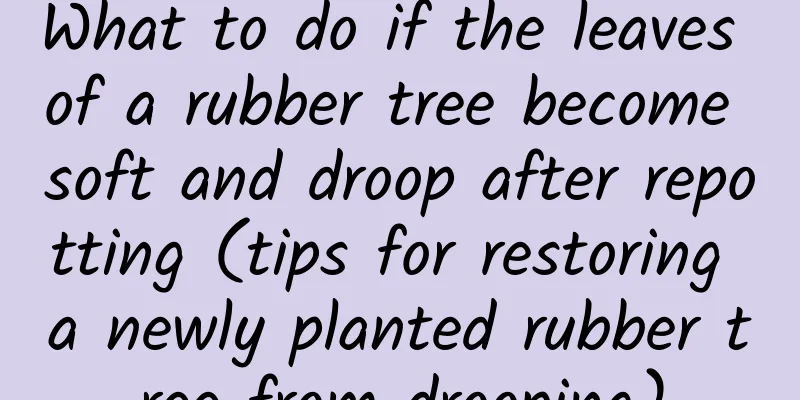What to do if the leaves of a rubber tree become soft and droop after repotting (tips for restoring a newly planted rubber tree from drooping)

What to do if the leaves of the rubber tree droop after repottingThere are many reasons why the leaves of rubber trees droop when repotting. First, the root system is damaged and the leaves droop during the recovery periodThe leaves of the rubber tree are thick and heavy. After repotting the rubber tree, the root system will be "disturbed" or broken when pruning the roots, and it will take a long time to restore the water absorption function. The heavy leaves plus water loss will cause the leaves of the rubber tree to droop. 【 Measures 】 For rubber trees that have just been repotted, the same watering method should be used: "watering when the soil is dry and watering when the soil is wet alternately". This not only replenishes water, but also allows the roots to breathe better, which is beneficial to the root recovery and growth. Another way to replenish water is to use the "spray" method to spray water on the leaves and increase the humidity of the environment. Second, soil reasonsThe soil of the rubber tree is the key to repotting. In addition to fixing the plant, the soil also needs to coordinate water, fertilizer, and air. Once the wrong soil is used, there are many reasons that will cause the rubber tree to rot and the leaves to droop. (1) The soil is too fine, which leads to water accumulation, a decrease in the amount of oxygen in the soil, and ultimately poor root breathing, which causes root rot. (2) The soil drainage is too good. Many rubber trees are planted using hard granular planting materials. The planting materials cannot retain water, which eventually causes the water to evaporate too quickly. The roots cannot be replenished with water in time, and eventually the roots die. (3) Too much soil nutrients. The nutrients and harmful bacteria in the soil are symbiotic. As nutrients increase, bacteria also increase, which will increase the chance of fungal infection of the rubber tree's roots after repotting. 【 Remedial measures 】 When repotting the rubber tree, you can use mixed soil. Mix farmland soil + freshwater river sand + humus soil in a ratio of one-third each, and then add one-tenth of honeycomb coal powder. It should have good drainage and moisture retention. It should have certain nutrients but it must be a light fertilizer type of soil. Third, environmental factorsRubber trees prefer warm and humid climates, and a sunny growing environment, but they also need shade under high temperatures. They are not heat-resistant or cold-resistant, and the suitable temperature for their growth is 16℃ to 35℃. The lowest temperature in winter must be above 10℃ to survive the winter safely, otherwise you can only consider bringing it indoors for the winter. Therefore, when caring for rubber trees, the environment is very important. Generally, you should also pay attention to the following after repotting: (1) When repotting a rubber tree, you should choose a temperature range that is suitable for the growth of the rubber tree, which is usually done in spring and autumn. As long as the temperature is stable between 16 and 28 degrees Celsius, it is the best time to repot. (2) After repotting, the rubber tree is in the period of time when the roots are recovering to absorb water. First, place it in a cool and ventilated place. After about 15 days, slowly increase the light exposure to a place with about 2 to 3 hours of light in the morning or evening every day under diffuse light. |
Recommend
Disease and Pest Control of Meiguanlan
Scaly mushroom They usually appear on the surface...
How to propagate Jade Bell
Cutting propagation of Jade Bell The main method ...
When is the best time to sow cornflowers
Suitable time for planting cornflower Cornflower ...
How many years does it take for avocado trees to bear fruit?
Avocado trees bear fruit after several years of p...
What to do if Yucca flowers are not blooming?
Yucca flowering period The flowering period of Yu...
How to Plant Coriander Seeds
Coriander Seeds Introduction Coriander will bloom...
Cutting method of Michelia
1. Selection of cutting materials Everyone should...
What to do if jasmine flowers are infested with insects
1. Insecticide method 1. Whiteflies: These insect...
How to hydroponically cultivate golden diamond
Hydroponics Method The hydroponic method of golde...
Can rice be used as fertilizer?
Rice as fertilizer Rice can be used as fertilizer...
What should I do if the orchid's leaves split? What is the reason?
1. Avoid strong light Reason: Orchids are suitabl...
How to prune five-color plum
When is the best time to prune the five-color plu...
How to Make Magnolia Bloom for Christmas
1. Keep warm indoors When the weather gets colder...
Sugarcane planting conditions are suitable for the environmental requirements of the planting area
Sugarcane Introduction Sugarcane, also known as p...
When should chrysanthemums be watered?
1. Watering time There is no fixed time for water...









